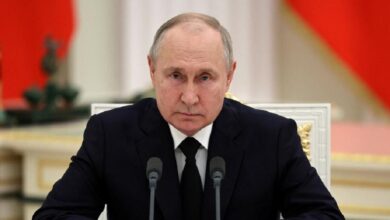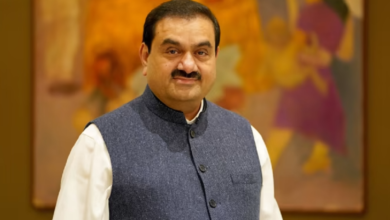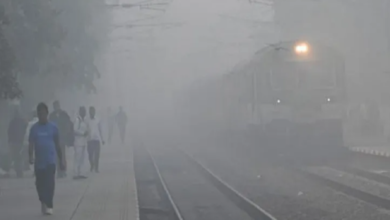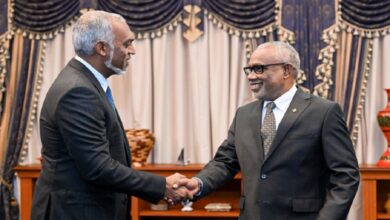How Indian media is trying to sway US policy in favour of Hasina
Experts believe that the series of misinformation since Trump’s triumph appears to be a strategy to influence policy changes regarding Bangladesh in influential nations, particularly the US.
India Today, one of the leading media outlets in our neighbouring country, published a report on 10 November titled “Bangladesh cracks down on Trump supporters after he decries anti-minority attacks”.
The report claimed, “On Friday [8 November] evening, several groups of people in Dhaka and other cities who had gathered to celebrate Trump’s emphatic victory in the US election were met with swift action by authorities, preventing them from holding the planned victory parades.”
The Chief Adviser’s Press Wing quickly stepped in to debunk the report, clarifying in a Facebook post that, “There have been no arrests or crackdowns on the supporters of US president-elect Donald Trump in Bangladesh.”
The post further clarified that dozens of Awami League activists, whose leadership, officials, and members have faced accusations of mass murders, corruption, and laundering billions of dollars, were arrested in the country on Sunday [10 November] on charges of planning subversive activities in the capital, Dhaka.
The Dhaka Metropolitan Police (DMP) also issued a statement confirming this. According to the statement, some of those arrested were carrying photos of Donald Trump, after the fugitive AL leader Sheikh Hasina allegedly instructed her supporters to display his portrait as a shield against arrest. The detainees told police that they did not follow US politics and only carried the Trump posters at Hasina’s command.
Despite the clarifications from both the Chief Adviser’s Press Wing and the DMP, India Today has yet to retract the misleading report or issue a correction. As of the publication of this story, they have not responded to our request for comment either.
While there had already been a significant amount of misinformation circulating in the Indian media following the ousting of Hasina, focusing on the violence on minorities, now it seems that a new wave of misinformation has emerged with the election of Donald Trump as the new US President.
In the long-term, it is essential that the Indian media invest a lot more effort in nurturing correspondents who have a genuine interest in Bangladesh and are able to understand the perspective of the Bangladeshi people instead of merely reproducing the perspectives of India’s foreign ministry.
Experts believe that this series of misinformation since Trump’s triumph appears to be a strategy to influence policy changes regarding Bangladesh in influential nations, particularly the US.
According to Jon Danilowicz, former deputy chief of mission at the Embassy of the United States of America in Bangladesh, the Indian right-wing media is behind spreading such misinformation about Bangladesh to undermine the new government and sustain Modi’s influence, by portraying the anti-Hasina uprising as extremist or foreign-backed, which could also sway US policy in favour of Hasina’s supporters.
“Most recently, these efforts have shifted to the United States where Hasina’s supporters hope to enlist Donald Trump in their effort to discredit Bangladesh’s revolution. The Hindutva lobbying effort ramped up in the wake of the disclosure of the Indian government’s attempts to assassinate political opponents in the US and Canada, which placed the Modi regime on the defensive. The Modi government and its supporters now hope for a change in US policy once President Trump takes office,” Danilowicz told The Business Standard.
According to him, since Hasina’s self-imposed exile in India, her supporters have been trying to rewrite history and redirect public opinion. Rather than defend Hasina’s misrule, these supporters have looked for ways to tarnish the image of the student protesters and the interim government which took office following her flight.
“They hold on to the fantasy that she will return to power. One line of attack has been to spread the fiction that the July revolution was part of an alleged foreign ‘regime change’ operation. Another has been to portray the uprising as an ‘Islamist plot’, resurrecting the traditional Awami League bogeyman of terming any dissenting voices as belonging to ‘anti-liberation forces’,” Danilowicz explained.
In the Indian media, there have been efforts to portray Chief Adviser Dr Muhammad Yunus and his government as wary of Trump, following the latter’s condemnation of violence against minorities in Bangladesh just before the election.
After Trump’s victory, Kolkata-based The Telegraph published a report titled “Yunus congratulates Donald Trump amid murmurs of discontent over election outcome”.
Press Trust of India (PTI) also attempted to portray the recent resignation of all members of Bangladesh’s National Human Rights Commission as a consequence of their monthly report, which highlighted an increase in crimes such as mob beatings, rapes, and other offences in October.
Some Indian media have sought to frame the interim government’s provisional approval for the Interim Government Ordinance, 2024, as “equivalent to establishing a dictatorial regime in Dhaka”.
“The idea is clear that every human or inhuman action is valid in Bangladesh. They want to curb human rights and courts will not see their actions. We have seen dictatorial regimes in the world, including in our immediate neighbour Pakistan, but no one does it by passing ordinance,” an intelligence source in India was quoted by News18.
Danilowicz cautioned that while neither of these false narratives are likely to gain traction in Bangladesh, there is a risk that they will resonate abroad.
Naresh Fernandes, editor of independent Indian media outlet Scroll, believes one of the underlying problems in the Indian media behind spreading misinformation about Bangladesh or publishing ill-informed reports is that no Indian publications have full time staffers in Bangladesh or cover it on a regular basis. Reports about Bangladesh, mostly from news agencies, appear in the Indian media mainly if there is a notable event — usually a natural disaster or a political upheaval.
“For the most part, we aren’t interested in the texture of everyday life in our neighbouring countries. As a result, we only see disruptions and fail to understand the underlying processes that have led up to these events,” Fernandes told The Business Standard.
He elaborated that the problem is compounded by viewing the recent developments through the prism of Hindutva politics. Characterising the attacks on Bangladeshi Hindus as genocide allows the BJP to justify its controversial Citizenship Amendment Act, which allows persecuted Hindus, Christians, Sikhs, Buddhists, Jains and Parsis from some neighbouring countries a fasttrack to Indian citizenship.
“Because of Sheikh Hasina’s close ties with India, the Indian media has long maintained the impression that the Awami League is the only viable ruling party in Bangladesh — that other parties are tainted by Islamist elements or in the case of the interim government are advancing an agenda set out by George Soros. These, naturally, are viewed as threats to India’s security,” Fernandes said.
“In the long-term, it is essential that the Indian media invest a lot more effort in nurturing correspondents who have a genuine interest in Bangladesh and are able to understand the perspective of the Bangladeshi people instead of merely reproducing the perspectives of India’s foreign ministry,” he concluded.




